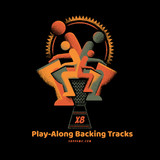Nanigo Rhythm
The Nanigo rhythm originated in the Yoruba tribes of Nigeria. It was
influenced by Cuban culture after being brought to Cuba from Africa
during the years of African-Cuban slave trade. It is thought that the
Nanigo rhythm originated from the religious worship of the Orishas
during a “Bembe,” or celebration of the spirits. It is the mysterious,
voodoo roots of the Nanigo beat, and the perception of its players,
that added to the repression of the African culture within Cuba.
The fear of the “Nanigo,” or the African male (whether from Nigeria or
not) in Cuba may have actually led to the ban of the Conga drum, a
modern staple of Cuban music, because it was feared that the Nanigo population would use the Conga drum as a means of communication between the communities, much like in tribal Africa.
The Nanigo rhythm, or any of the 6/8 rhythms of African-Cuban music, has evolved into the more common Cuban rhythms heard today like the son or rumba clave or even as a base for the mambo or salsa. Typically, the Nanigo is played on a Conga drum, but can also be adapted for the bongo or Djembe drum.
Since the Nanigo rhythm has been adapted for use in all genres of modern music, it is a commonly played rhythm that can be used for improvisation, drum solos or to keep a steady, and fast beat. It can be felt as either a 6 rhythm or a 4 rhythm, depending on the particular beats accented during its performance. The versatility of the Nanigo rhythm lends itself well not only to culturally-diverse musical compositions, but also to the smaller, more intimate drum circle music. The Nanigo rhythm can also be heard in modern music, but may be best known for its appearance in Frank Zappa’s How Could I Be Such A Fool?
As a celebration of spirituality and African culture, the Nanigo rhythm shines, even through its history during the African slave trade and subsequent treatment of the Nanigos in Cuba. It is a rhythm that has survived beyond politics and fear, and has become one of the more favored rhythms played today by many artists in different genres, including rock, pop and metal music.
The Nanigo rhythm, or any of the 6/8 rhythms of African-Cuban music, has evolved into the more common Cuban rhythms heard today like the son or rumba clave or even as a base for the mambo or salsa. Typically, the Nanigo is played on a Conga drum, but can also be adapted for the bongo or Djembe drum.
Since the Nanigo rhythm has been adapted for use in all genres of modern music, it is a commonly played rhythm that can be used for improvisation, drum solos or to keep a steady, and fast beat. It can be felt as either a 6 rhythm or a 4 rhythm, depending on the particular beats accented during its performance. The versatility of the Nanigo rhythm lends itself well not only to culturally-diverse musical compositions, but also to the smaller, more intimate drum circle music. The Nanigo rhythm can also be heard in modern music, but may be best known for its appearance in Frank Zappa’s How Could I Be Such A Fool?
As a celebration of spirituality and African culture, the Nanigo rhythm shines, even through its history during the African slave trade and subsequent treatment of the Nanigos in Cuba. It is a rhythm that has survived beyond politics and fear, and has become one of the more favored rhythms played today by many artists in different genres, including rock, pop and metal music.
29th Oct 2014
Recent Posts
-
X8 Drums Play-Along Backing Tracks
The new X8 Play-Along Series is being produced for our musician friends wanting a fresh way to work …9th Feb 2025 -
What is the Best Size Djembe for Beginners?
If you're new to the world of percussion and interested in learning the djembe, you're in for a t …16th Jul 2024 -
The Benefits of Becoming a Drumming Teacher: Transforming Passion into Profession
Why become a drumming teacher? Becoming a drumming teacher is an excellent way to share your pas …22nd May 2024



